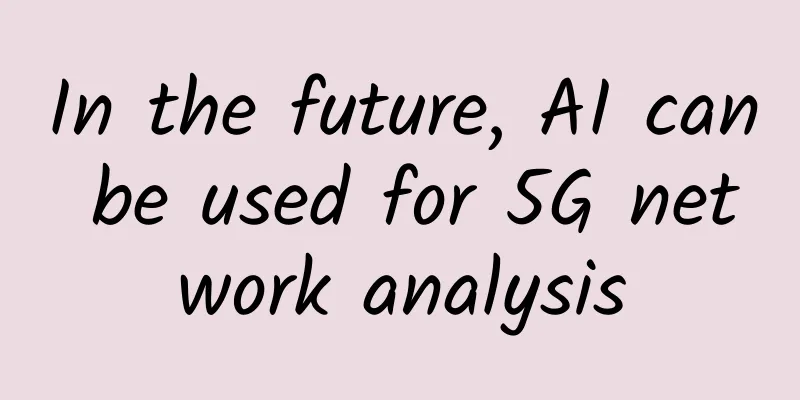In the future, AI can be used for 5G network analysis

|
There are many blogs and vendor papers about 5G right now, covering everything from new media transport to gigabit speeds to mobile devices. With seemingly unlimited bandwidth possibilities, the added value of moving to 5G is clear, but we need to consider the impact of this type of network. The number of cell sites and managed devices will grow dramatically, and it is not clear whether today's network designs can handle them.
Handling new levels of complexity and the potential for operational failure The real vision of 5G is to be able to deliver mobile services and wireless fixed broadband at gigabit speeds, forming a single 5G network through new wireless access types and spectrum bands. This will add tremendous complexity to existing wireless networks. For example, a mobile provider may need to add new customer premise equipment (CPE) to deliver video media in a customer's home. CPE devices include wireless set-top boxes (or dongles), wireless routers, and wireless bridges, which are used to forward ultra-high frequency (e.g. 30Ghz) signals from outside to inside the home. As CSPs adopt higher spectrum, these wireless relay devices may become commonplace. Due to the increasing spectrum usage, the design of the RAN must change. Currently, CSPs may have 70,000 cell sites, but soon they will find themselves operating hundreds of thousands of cell sites. As the number of managed devices 10x-100x of the new CPE increases, the operation becomes more complex, and each device generates thousands of data. Now that these millions of new devices may fail countless times every day, it is clear that the current operating practices and systems cannot maintain the expected service level, so it will be difficult to retain existing customers or win new customers. What should operators do? As CSPs prepare for 5G, those who may succeed in the 5G future are focused on introducing advanced network operations and customer experience systems into the network. However, with the increase in the number of network elements and connected devices, it will be almost impossible to operate a 5G network without the help of AI analytics. New consumer applications will drive a dramatic shift in the network. As augmented reality and virtual reality become more widely used, consumer demand for these applications will further consume bandwidth and increase network variability. This will drive the development of higher-density compute and storage systems that are closer to consumers and located at the edge of the network. Smaller, decentralized data centers will be needed to support burst capacity for everything from networks to services. The deployment of NFV and SDN and virtualized applications that were previously hardware-based systems spread across the country need to be specifically analyzed and then properly managed. The next generation of AI-based tools can be used to predict the impact of service failures and automatically trigger workflows to fix the problems experienced by customers. Additionally, we are seeing a big shift in customer expectations. Ever tried to call Google for support on Gmail? You simply can’t. From the beginning, many of our favorite content providers developed customer self-service systems, coupled with advanced analytics and automation to create a consistent service for customers at any time of the day. CSPs will be pushed in the same direction. 5G represents not only a significant network transformation, but also a transformation point for customer engagement and network operations. To enable this transformation, CSPs need an analytics framework that enhances existing data lake deployments by adding a rich set of analytics and application accelerators to extract and leverage data stored in the data lakes, add missing data, and quickly create analytical applications that solve critical business problems. Creating applications that can quickly access data in real time is critical to enabling the transition to 5G and true transformation. Using AI-powered analytics to change the way you interact with customers Accessible data will not only change how CSPs operate their networks, but also how they interact with their customers. In a typical scenario today, customer service, marketing, and network operations are all separate departments that do not share data with each other. From the customer's perspective, this results in siloed interactions, and customers may have very different experiences in each department. The marketing department may be trying to sell a customer a new feature or service when they just want the basic connection to be fixed. Using AI-driven analytics, data from the network can be shared, allowing all interested departments to easily view the customer as a whole using both raw and processed data. Each department can see the complete data of the customer and then create department-specific applications as needed. Next-generation network operation systems will be able to easily analyze trillions of pieces of data seamlessly generated by servers, applications, radios, routers, switches, SIMs, IoT modules, and CPEs. These analyses will be able to see small changes in normal patterns, early warning indicators of impending failures. With this information, CSPs will have the opportunity to classify data, prioritize workloads, and customers can use the system for self-service. In addition to predicting failures, analysis will help operations teams more quickly identify systems that may be causing problems. By proactively engaging with customers, many customer calls and trouble tickets can be avoided. By increasing uptime, higher quality service and a better overall experience can attract higher-level customers to join. |
<<: IPv6 conversion service - rapid business support for IPv6 practice
>>: SDN/NFV/CLOUD is too complex and AI and 5G accelerate the reconstruction of the network
Recommend
Verizon to launch 5G home internet service in Cleveland
Verizon announced Wednesday that it will launch 5...
Amid the epidemic crisis, many countries are planning to break through with 5G
For the global 5G industry, the first quarter of ...
The 18th China Enterprise Annual Selection List for 2023 was announced: Huawei's high-quality Ethernet all-optical network solution won the 2023 IT Industry Campus Network Excellent Solution Award
In November 2023 , the " China Enterprise &q...
Analysis: Which businesses need a dedicated wireless network?
Over the past few years, private wireless network...
DiyVM: Hong Kong dedicated server from 499 yuan/month, Japan/US/Hong Kong VPS from 50 yuan/month
DiyVM is a Chinese hosting company founded in 200...
How awesome is the next-generation camera polished by the Virgo Huawei technical team? A favorite for detail lovers!
[51CTO.com original article] Can cameras also tak...
Is there still room for wireless mesh networking in the enterprise?
【51CTO.com Quick Translation】Wireless mesh networ...
Wu Hequan: 5G's key performance has not yet been reflected in the application end. This year's positioning accuracy will be increased to 0.3 meters
[[375297]] Recently, Wu Hequan, an academician of...
BGP.TO Japan servers start at 35% off, Singapore servers start at 25% off, monthly payment starts at $93
BGP.TO is currently offering promotions for serve...
HostMayo: $2.5/month-1GB/20G SSD/unlimited traffic/Los Angeles data center
I searched the blog and found that the earliest i...
Before 5G mobile phones become popular, these problems must be solved first
Although information about 5G has attracted a lot...
China Unicom and China Telecom refuted the rumor that the first batch of 5G users were abandoned: it is impossible to take a radical one-size-fits-all approach
In response to rumors that "the first tens o...
6G transmission capacity may be 100 times higher than 5G. 5G is here. How far is 6G?
How long does it take to download a 1G high-defin...
Migrate to the cloud safely? See how Neusoft Cloud Start (NCSS) does it
Today, the development of cloud computing has rea...
Tungsten Fabric community arrives in China, first batch of members discuss the future of networking in the multi-cloud era
[51CTO.com original article] On November 7, as an...









